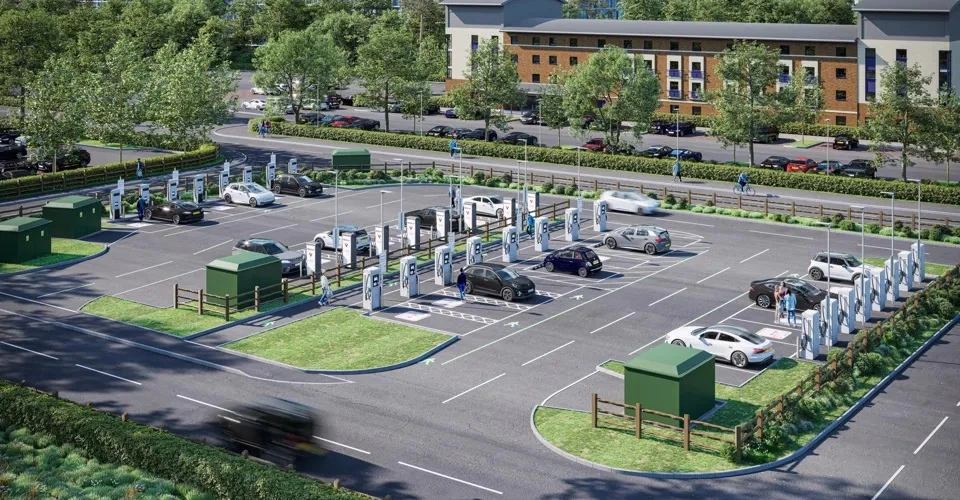As cities worldwide grapple with air pollution and congestion, the rise of electric vehicles (EVs) offers a beacon of hope for sustainable urban transport. Did you know that Bloomberg Green reported a 40% increase in urban EV adoption in 2023 alone? This surge is largely attributed to the advent of urban EV charging hubs, a transformative development in city transportation. In this article, we’ll explore how these hubs are reshaping urban mobility, offering practical insights into their benefits, and guiding you on how to make the most of them.
The Rise of Urban EV Charging Hubs
What Are Urban EV Charging Hubs?
Urban EV charging hubs are strategically located clusters of charging stations designed to accommodate the growing number of electric vehicles in city centers. Unlike standalone chargers, these hubs offer multiple charging points in one location, making it easier for EV owners to find a spot and reduce charging wait times.
- Strategic Locations: Typically placed near shopping centers, public transit stations, and parking lots.
- High Capacity: Equipped with fast chargers to minimize downtime.
- Integrated Services: Often include amenities like cafes or convenience stores.
Why Are They Important?
Urban charging hubs play a crucial role in the wider adoption of EVs by addressing one of the major concerns of potential EV buyers: charging availability. According to Electrek, the presence of nearby charging infrastructure is a top factor influencing EV purchase decisions.
- Improved Accessibility: More charging locations lead to less range anxiety.
- Efficient Use of Space: Maximizes the utility of urban areas.
- Environmental Benefits: Encourages more people to switch to cleaner transportation.
The Impact on City Transportation
Reducing Urban Congestion
Urban EV charging hubs contribute significantly to reducing city congestion. By strategically placing these hubs, cities can:
- Encourage Park-and-Charge: Drivers can charge their vehicles while using public transport.
- Promote Carpooling: Dedicated parking spots for electric carpool vehicles.
- Optimize Traffic Flow: Decrease the need for EV drivers to circle the block searching for chargers.
Enhancing Public Transit Integration
Many cities are integrating EV charging hubs with public transportation networks. For example, a recent initiative in Los Angeles combines charging stations with metro stops, allowing commuters to charge their cars while taking the train. This seamless integration not only saves time but also promotes the use of both personal and public transport.
Supporting Green Initiatives
Urban EV charging hubs are pivotal in supporting municipal green initiatives. Cities like Oslo and Amsterdam have already set ambitious goals to become emission-free by 2030, relying heavily on the expansion of charging infrastructure to meet these targets.
Practical Guide to Using Urban EV Charging Hubs
How to Charge at an Urban Hub
Charging at an urban EV hub is straightforward, but here are some tips to ensure a smooth experience:
- Plan Ahead: Use apps like PlugShare or ChargePoint to locate available hubs.
- Check Connector Types: Ensure compatibility with your vehicle’s charging port.
- Time Your Visit: Avoid peak hours to minimize wait times.
Where to Find the Best Hubs
Some of the most well-equipped urban EV charging hubs can be found in cities leading the EV revolution:
- San Francisco: Known for its extensive network of fast chargers.
- London: Offers numerous hubs integrated with public transport.
- Shanghai: Features high-capacity hubs with solar-powered stations.
What to Compare When Choosing a Charging Hub
When selecting a charging hub, consider the following factors:
- Charging Speed: Look for hubs offering fast charging (50 kW+) to reduce wait times.
- Cost: Compare pricing models—some hubs offer subscription services for frequent users.
- Availability: Check real-time availability via mobile apps to avoid queues.
Conclusion: The Future of Urban Mobility
Urban EV charging hubs are not just a trend; they are a cornerstone of sustainable urban mobility. By making EV charging more accessible and integrated, these hubs are paving the way for a cleaner, more efficient future in city transportation. As more cities adopt this model, we can expect a significant reduction in urban pollution and congestion, leading to healthier living environments.
As an EV enthusiast, what changes have you noticed in your city? Are you ready to embrace this revolution in urban transportation? Let us know your thoughts and experiences in the comments below. Looking ahead, the expansion and innovation in urban EV charging hubs will undoubtedly continue to shape the way we live, work, and travel in our cities.

